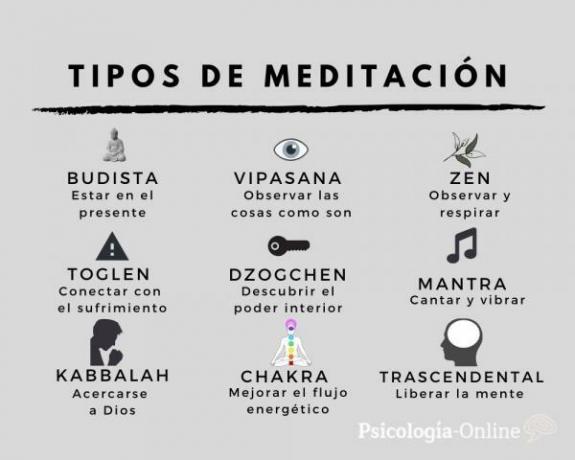
Once upon a time, in a region between Nepal and India called Kapilavastu, there lived a royal descendant who got tired of his wealthy and routine life. One night the young man decided to sit under a fig tree until he found true knowledge. He was Siddharta Gautama, better known as Buddha, a relevant character in the history of meditation who highlighted his own experience as a source of knowledge.
Some 2,500 years later, in some mind of our society: “Tomorrow I have to deliver a work for the university, how much do I have left? I think a couple of sections, how will the meeting my brother? I have to buy bread, I don't know what time they close, I never remember, I'll buy a snack to take with my friend, It is her birthday and last year I forgot to congratulate her, what a bad memory I have, but it does not surprise me with the pace of life that I lead. "
This mental speech is very frequent. Our ability to anticipate the future allows us to avoid potential problems or resolve issues in advance. On the other hand, taking into account the past allows us to learn from previous experiences. Both questions are really useful. But, if we focus on the past and / or the future,
Index
- Meaning of mindfulness
- What is mindfulness?
- Mindfulness: Westernized Meditation
- Benefits of mindfulness
- Mindfulness: how it is practiced
- Start practicing mindfulness
- Mindfulness: exercises
- Mindfulness exercise with music
- Mindfulness books
Meaning of mindfulness.
To know what mindfulness is and how it is practiced, we must first know what mindfulness means. The meaning of mindfulness is full attention or mindfulness. Mindfulness is an English term, an old synonym for attentionwhich means attention. Mind means mind, while fulness means fullness. The origin of the word mindfulness is found in the term sati, which in Pali means awareness, attention and remembrance. The concept of mindfulness currently refers to the fact that be aware and attentive to the present moment. Although it can be translated into the Spanish language, experts recommend using the Anglo-Saxon term or the Pali term, as they better reflect the meaning of mindfulness
What is mindfulness?
What is mindfulness? Mindfulness is a meditation-based practice that consists of training attention to be aware of the present. What is mindfulness meditation? According to Jon Kabat Zinn (1994), mindfulness is intentionally pay attention to the present moment and without judgment. While for Vicente Simón (2007), one of the maximum representatives of mindfulness in Spain, it is a capacity universal and basic human that consists of the possibility of being aware of the contents of the mind from moment to moment.
Mindfulness stems from Eastern traditions, especially Buddhism and, specifically, Vipassana meditation. The origin of mindfulness dates back 2,500 years, when Siddharta Gautama perfected a religious and philosophical practice that had mindfulness as its essence.
What is meditation?
Meditation is a way to train the mind. Mindfulness is based on meditation, but this is a much broader and more heterogeneous practice. You will find more information about meditation in this article: Types of meditation and their benefits.
What is vipassana meditation
Vipassana meditation is a type of meditation originating in India. Vipassana means "seeing things as they are" and this is the goal of this type of meditation. It is practiced byself-observation of the body, the mind and its changes.
Mindfulness: westernized meditation.
Mindfulness is said to be a type of westernized meditation since it has been adapted to the needs of life in the West.
Although meditation is an ancient practice, it began to spread in the West at the beginning of the 20th century. It was established between the 60s and 70s, entering the schools of psychology. Little by little, mindfulness was incorporated as a technique to be used by physicians in their professional practice. The maximum exponent of this process is Jon Kabat-Zinn, who in 1979 inaugurated the center for mindfulness at the University of Massachusetts School of Medicine and promoted the mindfulness-based stress reduction program.
Since then, research on mindfulness has multiplied exponentially, disclosing findings about its multiple benefits.
The mindfulness meditation that we use in contemporary psychology does not need a specific body position and is not related to any type of religious belief. It consists of a practice to focus attention in the present moment and skillfully respond to mental processes, thus influencing stress and behavior.

Benefits of mindfulness.
The most important benefits of mindfulness are the following:
Regulation of care
Attention is like a spotlight that illuminates a stage. This stage is very large and the light bulb cannot illuminate everything, but it illuminates a specific part. The stimuli we process depend on our attention and such significant issues such as memory and learning depend on this. For all this, knowing how to move this focus and light what is most important to attend to at all times it's of vital importance. Mindfulness allows training the regulation of attention and allows us to be aware of what we tend to overlook when we activate the automatic pilot.
Mindful moments
In order to meet the demands of today's society, the pace of life is, in general, accelerated. Learning mindfulness allows you to deactivate the automatic pilot and facilitates having more mindful moments, that is, moments when you are aware of the present.
Mindfulness and emotions
Mindfulness or mindfulness, by focusing on the present moment, allows be aware of what you are feeling right now. With this, we can suffer less from emotions felt in the past, anticipate less emotions that may arise in the future and also be more aware of what emotions we are feeling in the present, in this moment. Knowing the current emotional state is the first step to regulate it. Emotional regulation consists of adapting emotional expression to the situation.
Detect thoughts
The mind does not stop bombarding thoughts continuously. Being aware of this activity allows you to manage it. There are thoughts that have no real function at that precise moment and produce a background noise in the mind. Through mindfulness, we can let go of these thoughts to focus on what we want.
Mindfulness to study
Studying while keeping your attention fully focused on what you read is a mindfulness action. Mindfulness helps study by improving the regulation of attention and decreasing the flow of distracting thoughts.
Relaxation and mindfulness
It should be noted that mindfulness is not a relaxation technique and it is not its main objective. However, it can be a beneficial consequence.
Mindfulness and anxiety
Anxiety is a normal and functional emotion, which serves to activate the body in the face of possible danger. However, sometimes anxiety becomes pathological since the activation is excessive and prevents normal functioning. Anxiety stems from a strong concern for the future, from an anticipatory fear. Therefore, mindfulness or mindfulness, helps reduce anxiety focusing attention on the present moment.
Mindfulness and relationships
Through the practice of mindfulness, they also improve relationships with other people, since it encourages the development social skills like the capacity for empathy and understanding.
Mindfulness and education
The benefits of mindfulness in the field of education they are increasing creativity and improving academic performance.
Mindfulness and brain
How does mindfulness affect the brain? The dorso-lateral prefrontal cortex is activated with attention and self-observation, while with metacognition the prefrontal cortex is activated, favoring a more conscious processing of information.
The thalamic-cortical networks of the brain create predictions for the future with the information that is captured through the senses through a very powerful neural connectivity. This allows the brain to issue quick assessments in order to perform behaviors consistent with survival. However, it also shapes the mind in terms of good or bad and encourages intense reactions based on previous experiences. Mindfulness allows you to stop identifying with that functioning, being aware that this mental activity does not represent the "I" and thus disconnecting the automatic processes.
Mindfulness and neuroscience research has found that the practice of mindfulness is related to a increased thickness of the medial prefrontal area and the insula. They also indicate that mindfulness practice is associated with changes in gray matter concentration in areas of the brain responsible for memory, learning and emotion regulation.[1]
Mindfulness: how it is practiced.
How is mindfulness practiced? Before starting, it is important to know the different components of mindfulness to learn how to practice it.
1. To be aware
It is about paying attention fully in the present moment, that is, be aware of what is happening here and now. It is about being aware of what is being done and what is going through the mind at this moment: the information that the senses and the mind's own products are capturing (thoughts, memories, imaginations, etc).
2. Watch
It is about observing what appears to the mind as constantly changing content. Simply observe what appears.
3. To accept
Thoughts will appear that could cause rejection or disgust. However, mindfulness tries to accept and allow thoughts to be as they are. Acceptance consists of do not put resistance.
4. Not judge
Not judging the thoughts that appear in the mind consists of refrain from conducting an assessment or a reaction, either positive or negative.
5. To experience
Mindfulness proposes a curious and open-minded attitude, with which sensations are received present with curiosity, as if it were the first time they appeared, avoiding the influence of previous learning.
6. Compassion
One of the essential components of mindfulness is attitude of loving kindness and kindness towards the observed object. You will find more information about this component in this article: self-compassion in psychology.
7. Release
Letting go means letting go of things that are leaving without trying to retain them. It consists in understanding that everything is impermanent, that everything has a beginning, a duration and an end. When this end happens, from the mindfulness it is proposed not to cling, but to let go. That is, letting go of the experience.
8. Patience
Being patient in the practice of mindfulness means understanding that things happen when they have to.
9. Trust
Confidence consists of believing in yourself, in your own feelings and in your own intuition and wisdom.
Definitely, practicing mindfulness consists of let your thoughts flow without resisting or judging them, simply observing how they come and go. It is important to differentiate the fact of focusing attention and the attitude with which it is done. In addition to focusing attention on the present, an attitude characterized by curiosity, openness and acceptance should be adopted.
Types of mindfulness practice
The practice of mindfulness can be formal or informal. Formal mindfulness practice requires a minimum of 45 minutes a day doing mindfulness meditation exercises. On the other hand, the informal practice of mindfulness consists of applying mindfulness skills in any daily action such as eating or walking.
In the Mindfulness-Based Stress Reduction Program (MBSR) and Mindfulness-based cognitive therapy (MBCT), both formal and informal practice are used. Instead, in therapy behavioral dialectic (DBT) and in acceptance and commitment therapy (ACT) only informal practice is used.
Start practicing mindfulness.
It is recommended to start practicing mindfulness with the help or accompaniment of a professional, through a mindfulness class or mindfulness session. The steps to practice mindfulness would be:
- Know and understand the technique.
- Dedicate a space in time to practice it.
- Start with simpler exercises.
- Increase the difficulty of the exercises until you can apply mindfulness in daily activities.
- Practice mindfulness in everyday activities.
Raisin exercise
One of the most used exercises to understand and start practicing mindfulness is the raisin exercise. This exercise is divided into 2 parts: in the first, the instruction is eat a raisin regularly. In the second part, the slogan is follow the next steps:
- Hold the raisin with your hand or fingers and observe it as if it were the first time you have seen a raisin.
- See and observe carefully all the details of the raisin: the color, the folds, and so on.
- Touch and listen. Explore the texture of the raisin, move it, squeeze it and listen to the sound.
- Smell.
- Place the raisin in your mouth and explore the sensation of having the raisin on your tongue.
- Chew: bite the raisin and perceive the texture and flavors of the raisin in the mouth.
- Swallow.
- Note the posterior effectors.
The raisin exercise ends with the reflection on the experience eating the raisin regularly and eating it with mindfulness, being mindful or practicing mindfulness.
Here are some other simple exercises to start practicing mindfulness.

Mindfulness: exercises.
There are different types of mindfulness exercises and mindfulness techniques. In this case, mindfulness exercises for adults and children will be detailed. In the following article appear mindfulness exercises for kids.
Guided mindfulness exercises are a good place to start. There are guided mindfulness recordings made by experts like Vicente Simón.
Another type of simple mindfulness exercises that are most practiced are quick mindfulness exercises that can be done in a few minutes and anywhere. The instructions for these exercises are the same, since they have a common denominator: there is something that will be used to focus attention. If at any time a thought crosses and you stop paying attention to the object, nothing happens. Simply that thought will be kindly let go and the attention will be refocused on the object.
Mindfulness exercises in 5 minutes
- Body sweep. This mindfulness exercise consists of finding a comfortable position and doing a review of the whole body, paying attention and being aware of the state and position of each part.
- Breathing. Pay attention to your breath in each step of your process. Be aware of the inhalation, of the sensation of the air entering through the nose, filling the lungs and leaving through the mouth. Discover different breathing exercises.
- Sailing. Light a candle and focus attention on the flame. Observe its movement, its change and its colors.
- Bath or shower. At the time of the bath or shower, pay attention to the sensation that occurs when the water touches the skin, be aware of the temperature of the water, the intensity, etc.
- Drink. This mindfulness exercise consists of taking a drink with full consciousness, that is, first of all observe it, touch it, listen to it, savor it and drink it paying attention.
In the following article you can find more mindfulness exercises for beginners.

Mindfulness exercise with music.
Listening to music with your full attention is also an exercise in mindfulness. You can practice with the following video:
Mindfulness books.
Some of the best known and most successful mindfulness books are the following:
- Learn To Practice Mindfulness, Vicente Simón (2011).
- After the ecstasy, the laundry. How the wisdom of the heart grows on the spiritual path, Jack Kornfield (2014).
- The mindfulness book, Bhante Henepola Gunaratana (2012).
- Full Catastrophe Living: Using the Wisdom of Your Body and Mind to Face Stress, Pain, and Illness, Jon Kabat ‐ Zinn (2008).
- The Practice of Mindfulness (Perennial Wisdom), Jon Kabat ‐ Zinn (2016).
- Mindfulness: curiosity and acceptance, Javier García Campayo (2015).
- Mindfulness. Practical Guide, Danny Penman (2016)
- The Miracle of Mindfulness: A Manual on Meditation, Thich Nhat Hanh (1975).
This article is merely informative, in Psychology-Online we do not have the power to make a diagnosis or recommend a treatment. We invite you to go to a psychologist to treat your particular case.
If you want to read more articles similar to Mindfulness: what it is and how it is practiced, we recommend that you enter our category of Meditation and relaxation.
References
- Parra, M., Montañés, J., Montañés, M., & Bartolomé, R. (2012). Knowing mindfulness. ESSAYS, Magazine of the Faculty of Education of Albacete, 27, 29-46.
Bibliography
- Goldstein, E., & Stahl, B. (2016). The Mindfulness Handbook: Mindfulness-Based Stress Reduction (MBSR) Program Daily Practices. Editorial Kairós.
- Kabat-Zinn, J. (1994). Wherever you are, there you go. Hyperion: New York
- Simon, V. (2007). Mindfulness and neurobiology. Journal of Psychotherapy, 66 (67), 5-30.
- Simon, V. (2013). Mindfulness and psychology: present and future. Psychological information, (100), 162-170.
- Vasquez-Dextre, E. R. (2016). Mindfulness: General Concepts, Psychotherapy and Clinical Applications. Journal of Neuro-Psychiatry, 79 (1), 42-51.


